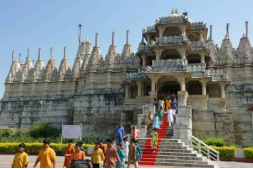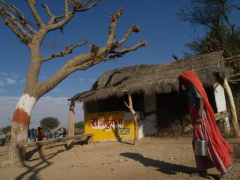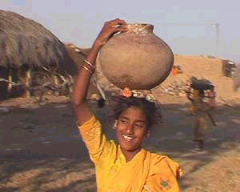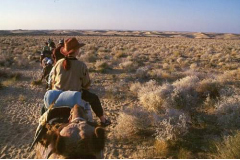Day 07: Udaipur/ Ranakpur / Rohet (240 Kms) (05 Hrs Drive)
Following breakfast we ride out to Rohet Enroute we visit Ranakpur.
The Ranakpur Jain Temple was built during the reign of the liberal and gifted monarch Rana Kumbha in the 15th century. The basement is of 48, 000 sq. feet area that covers the whole complex. There are four subsidiary shrines, twenty-four pillared halls and eligibly domes supported by over four hundred columns. The total number of columns is 1,444 all of which are intricately carved with no two being alike. The artistically carved nymphs playing the flute in various dance postures at a height of 45 feet are an engrossing sight. In the assembly hall, there are two big bells weighing 108 kg whose sound echoes in the entire complex. The main temple is of Chaumukh or four-faces temple dedicated to Adinath. From here we continue our ride to Rohet
Upon arrival, check into Rohetgarh Fort
 At Rohet, one is transported in to a world of the past, a world of honour and of chivalry, of glory and of pride; a world of vibrant colours and spectacular magnificence. Past centuries come to life at the historic boundary walls of Rohet- the 16th century fortified deserted home of a Rajput clan. Within the precincts of these time weathered walls is our hotel, the impressive Rohetgarh Fort- a bastion of proud Rajput traditions bathed in the ambience of unmistakable Rajasthani culture where one can, even today experience the famed warm and courteous Rajput hospitality. Frescoes on the tall gateway, brightly painted in the traditional style, using traditional motifs and colour schemes herald your entry to this charmed world the bygone era. The gateway leads to a compound where a profusion of flowers frame the archways in welcome. The portico is a warm and informal place decorated with the artifacts and trophies of many years. Exquisitely carved furniture, delicate hand block prints, original paintings and photographs decorate your rooms, which though redolent with the romance of a bygone era, provide all the modern amenities. Antique hunting riffles, shields & spearheads, daggers and original paintings form the backdrop of the dinning room. The swimming pool here is in beautiful settings and is an oasis in a dessert.
At Rohet, one is transported in to a world of the past, a world of honour and of chivalry, of glory and of pride; a world of vibrant colours and spectacular magnificence. Past centuries come to life at the historic boundary walls of Rohet- the 16th century fortified deserted home of a Rajput clan. Within the precincts of these time weathered walls is our hotel, the impressive Rohetgarh Fort- a bastion of proud Rajput traditions bathed in the ambience of unmistakable Rajasthani culture where one can, even today experience the famed warm and courteous Rajput hospitality. Frescoes on the tall gateway, brightly painted in the traditional style, using traditional motifs and colour schemes herald your entry to this charmed world the bygone era. The gateway leads to a compound where a profusion of flowers frame the archways in welcome. The portico is a warm and informal place decorated with the artifacts and trophies of many years. Exquisitely carved furniture, delicate hand block prints, original paintings and photographs decorate your rooms, which though redolent with the romance of a bygone era, provide all the modern amenities. Antique hunting riffles, shields & spearheads, daggers and original paintings form the backdrop of the dinning room. The swimming pool here is in beautiful settings and is an oasis in a dessert.
The food at Rohetgarh is special; each recipe is both traditional and typical, handed down the generations and jealously guarded to retain its pristine flavours. You savour only the very best of Rajasthani cuisine’s, food favoured by the Royalty. The 16th century descendants of the Rathore ruling family still live here and host the guests. The members of the Royal family interact with the guests and interesting stories and anecdotes are narrated.
We would also explore Rohet, which is a fascinating small feudal town, which seems to be straight out of the Arabian Nights. There is no proper road here - only one main dust trail. On either side are typical thatched houses and shops of all kinds - colourful bangles, silver jewellery, potters, fruit vendors on carts, dress shops, tailors etc.
 Late afternoon we enjoy jeep safaris to visit the heart of Rajasthan villages where traditions centuries old still permeate life styles. One can witness the ‘opium ceremony’ - a ritual by which guests are welcomed. Gaily attired men and women carry on their chores and one can catch a glimpse of their norms and customs. The smoothened mud floors of the village huts remind one of the simple and traditional living here.
Late afternoon we enjoy jeep safaris to visit the heart of Rajasthan villages where traditions centuries old still permeate life styles. One can witness the ‘opium ceremony’ - a ritual by which guests are welcomed. Gaily attired men and women carry on their chores and one can catch a glimpse of their norms and customs. The smoothened mud floors of the village huts remind one of the simple and traditional living here.
As evening descends, the darkness of the night is lit up by the flickering flames of fire around which the rhythmic movements of the folk dancers assumes shape in brilliant colours; truly an electrifying experience.
Overnight at Rohetgarh – a Heritage Property (Super Deluxe Room)
Day 08: Rohet / Mirvana (160 Kms) (03 Hrs Drive)
Following breakfast, ride out through desert country to Mirvana. For miles altogether, there is nothing but sand, but from this aridness one can expect the unexpected as groups of women appear and disappear in their colourful clothes, apparently going nowhere. Just as suddenly, medieval cities rise, magnificent for their architectural heritage, and are just as suddenly lost to sight. Mirages? No, in the Thar, these are only too real. We will have opportunities to stop on the way and interact with tribals and villagers in remote countryside.
 Upon arrival, check into Mirvana Nature Resort. Escape from the hustle and bustle and enjoy a delightful stay at Mirvana Nature Resort, which offers the tranquility of greenery within an otherwise harsh desert. Mirvana Nature Resort is a perfect place to experience nomadic desert life at its best.
Upon arrival, check into Mirvana Nature Resort. Escape from the hustle and bustle and enjoy a delightful stay at Mirvana Nature Resort, which offers the tranquility of greenery within an otherwise harsh desert. Mirvana Nature Resort is a perfect place to experience nomadic desert life at its best.
Evening we visit the nearby Sand Dunes and enjoy camel rides as we explore desert life in all its peace, tranquility and of course draped in its colourful richness. We enjoy tea as we witness the Sun setting in the horizon and camels with their shepherds forming nice sillouttes in the foreground
Overnight at Mirvana Nature Resort (Standard Tent)
Day 09: Mirvana
Today we explore the primitive Sadakore village which exists back in time. Traditional camel dung plastered homes, crafts, occupation take us back in time. The disarming hospitality of the natives and their brightly coloured traditional outfits form an indelible imprint on our hearts and minds.
Besides, Sodakore is a destination for several domestic bird species during the winter season. It is a classic habitat for the Great Indian Bustards, which are an endangered species. Some major fauna present are the Desert Fox, Desert Cat, antelope species, like the Chinkara and Blue Bull.
Overnight at Mirvana Nature Resort (Standard Tent)
Day 10: Mirvana / Jaisalmer (160 Kms) (03 Hrs Drive)
After breakfast we will drive to Jaisalmer. The drive is through desert country with scantly vegetation and life stock in view.
Upon arrival, check the Hotel Rawalkot
After rest and relaxation, we will visit, Salim Singh ki Haveli, Patwon ki Haveli, and Nathmal ki Haveli
Salim Singh ki Haveli : Constructed on the remains of an older haveli, Salim Singh Ki Haveli in Jaiselmer is yet another unique work of architecture, built in the late 17th century.
Patwon ki Haveli : The grandeur and the architecture of Patwon Ki Haveli adds immense value to the cultural heritage of the city.
Nathmal ki Haveli : The architects of this haveli were two brothers Hathi and Lulu who started building different facets of haveli simultaneously with their immense talent and skill. However, in those days there was no modern equipment, which could keep a track on continuity and thus when this building finally built it had an irregular shape.
Later, we will now make our way to the beautiful Bada Bagh, literally meaning big garden, features a series of royal cenotaphs or chhatris of Jaisalmer. The first cenotaph in the region was built for Jai Singh II by his son, Lunkaran, in the 16th century. Jai Singh II was known for his contribution to making the city green. And to honour him, his son set up a memorial in the form of cenotaph near the dam and created a big park around it. All the cenotaphs here have a beautifully carved ceiling and elegant equestrian statues of rulers. The location of the garden is such that it offers incredible sunset vistas to travellers.
Overnight at Hotel Rawalkot (Deluxe Room)
Day 11: Jaisalmer / Khuri / Jaisalmer (50 Kms – One Way) (01 Hrs Drive)
This morning we visit the residential portions of the Jaisalmer Fort., where one third of the population of the old City still lives. The designs of the houses here remain as they used to a couple of centuries behind time, and so do the lifestyles of the people inhabit them. This is so as most of the families continue to work for generations for the ruler (though only titular now). Hence, there is a sense of continuity. The houses are arranged in narrow lanes and have small windows from where the shy child or the girl peeps through. This city is believed to be the home of the most handsome men and the most gorgeous women in Rajasthan. We would also walk through the narrow cobbled lanes of the golden sandstone city to witness the magnificent medieval Indian Havelis (mansions) of medieval Indian merchants. These elegant buildings, which are very well preserved, tell an apt story of how medieval Indian society existed.
 Afternoon, we will drive on an excursion to the fascinating desert village dunes of Khuri, located near sand dunes for another 'Indian experience', and, a memory to be treasured. The friendly locals would invite you into their simple homes, little mud houses with earthen floors, no electricity or running water. The women walk two kilometers to the well & carry the water home on their heads. Life is very primitive here restricted to basic activities centered around the little mud hut. The rough terrain here does not support cultivation, hence the entire village work as causal labourers in road works or community projects. Inspite of their poverty and hard life the people are very friendly and seem to be aware that they are proud owners of very expressive and beautiful faces. In the evening we explore the dessert on camel back. Against the backdrop of the setting sun and the huge expanse of the dessert the camels with their long shadows would be excellent pictures. The stillness of the dessert, the clear sky, local Rajasthani music and the general atmosphere, make the place a very romantic experience.
Afternoon, we will drive on an excursion to the fascinating desert village dunes of Khuri, located near sand dunes for another 'Indian experience', and, a memory to be treasured. The friendly locals would invite you into their simple homes, little mud houses with earthen floors, no electricity or running water. The women walk two kilometers to the well & carry the water home on their heads. Life is very primitive here restricted to basic activities centered around the little mud hut. The rough terrain here does not support cultivation, hence the entire village work as causal labourers in road works or community projects. Inspite of their poverty and hard life the people are very friendly and seem to be aware that they are proud owners of very expressive and beautiful faces. In the evening we explore the dessert on camel back. Against the backdrop of the setting sun and the huge expanse of the dessert the camels with their long shadows would be excellent pictures. The stillness of the dessert, the clear sky, local Rajasthani music and the general atmosphere, make the place a very romantic experience.
Late evening we will drive back to your hotel in Jaisalmer
Overnight at Hotel Rawalkot (Deluxe Room)